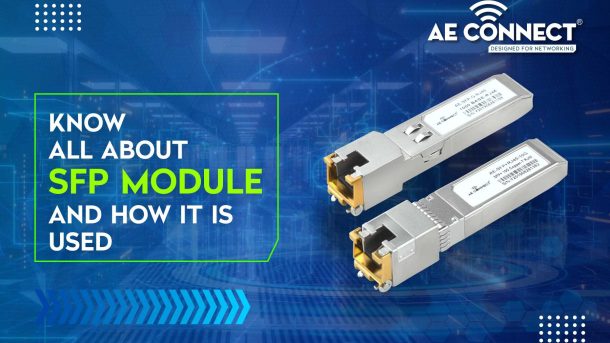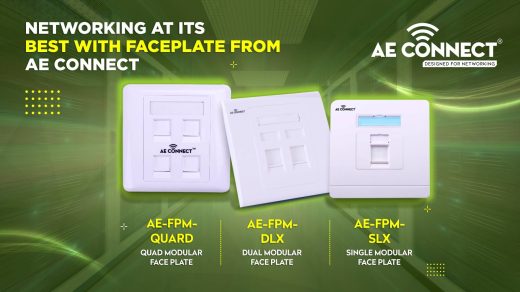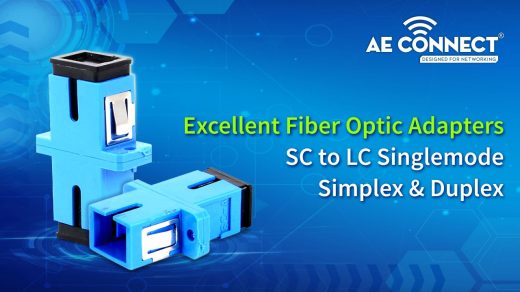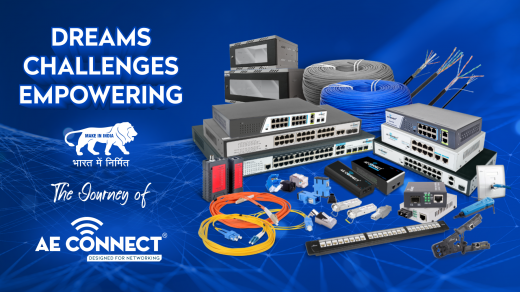Small form-factor pluggable, or SFP, devices are hot-swappable interfaces used primarily in network and storage switches. The SFP ports on a switch and SFP modules enable the switch to connect to fiber and Ethernet cables of different types and speeds. AE Connect SFP Module works seamlessly with all known OEM brands and comes with Three Years Warranty. Available for 1G and 10G switches. Even now, manufacturers and service providers from all over the world continue to use SFP modules as the industry standard. For more than 20 years, it has served as the industry workhorse in numerous networks, including SONET, Gigabit Ethernet, Fibre Channel, PON, and other communication protocols. SFP, often known as mini-GBIC, stands for small form-factor pluggable (gigabit interface converter). A network switch or server’s SFP port accepts small modular transceivers called SFP modules. Due to its tiny size and ability to be employed in confined networking environments to offer quick communication between switches and crucial networking components, the SFP module has largely supplanted the GBIC module in applications.
AE Connect manufactures an SFP module that delivers high performance at all times. Additionally, SFP modules are hot-pluggable, making it simple to modify current networks without completely redesigning the cable infrastructure.
A minimal Form-factor Compact, hot-pluggable network interface module technology known as Pluggable (SFP) is employed in both data communications and telecommunications applications. A media-specific transceiver, such as one for a copper cable or fiber-optic cable, can be installed in a modular slot called an SFP interface on networking devices. The benefit of employing SFPs over fixed interfaces (such as Ethernet switches’ modular connections) is that each port can be customised with the appropriate transceiver.
Three primary factors make SFP a well-liked transceiver. The compact form factor comes first. Due to its small size, it can be employed in confined networking environments to enable quick communication between switches and crucial networking elements. The range of SFP connection possibilities is the second factor contributing to its widespread use. Our SFP module comes at affordable prices and leads to easy networking. Copper or fibre optics are compatible with SFP. There are only so many networks that can’t use SFP. SFP can finally be hot-swapped. It is therefore perfect for growing or modifying existing networks without requiring a complete rebuild of the cable infrastructure. An SFP transceiver sometimes referred to as an SFP module, is merely a hot-swappable, pinky-sized metal component that permits data transmission when linked to another device through a cable.
In most applications, the SFP took the place of the bigger gigabit interface converter (GBIC), and some suppliers have referred to it as a Mini-GBIC. Small Form Factor Pluggable (SFP), which may be inserted into an SFP port or socket on an Ethernet switch or media converter, is essentially a fibre optic module. It allows seamless data transmission and reception by conversion of Ethernet signals into optical signals. They are utilised in network interface cards (NICs), Ethernet switches, firewalls, and other devices to serve as an interface between a network device or a device motherboard and the networking cable. They are also referred to as tiny Gigabit interface converters (GBICs). On the same panel, you can configure many ports using an SFP module. The majority of businesses utilise switches that have two or more SFP ports, which enables them to be used in network topologies like the ring, star, bus, and so on.
SFP Variety
SFP is designed to work with the vast majority of modern networks. For gigabit Ethernet networking, 1000BASE-T and 1000BASE-TX modules are generally found on the copper side. As long as everything is within 100 metres of each other, SFP modules are good for bridging communications between switches in small contexts. There are a ton of alternatives on the fibre optics side of the equation. Single-mode and multi-mode fibre are supported by SFP modules. Both simplex and duplex are compatible. Options for the wavelength range from 850 nm to 1550 nm. The distances between networks might range from 500 metres to more than 100 kilometres. Overall, every job has an SFP module.
SFP Compatibility
SFP compatibility is surprisingly difficult. For these modules, there isn’t a defined, controlled worldwide standard. Instead, the multi-source agreement is where compatibility is found (MSA). This agreement is backed by a variety of manufacturers who collaborate to try and offer a dependable way to properly mix and match SFP brands. Despite the MSA, the issue is that SFP modules frequently perform better when brands are not intermingled. It makes an intriguing barrier for equipment cost optimization. You can stick to MSA recommendations and attempt to utilise less expensive parts in various network components, or you can simplify compatibility and stick with a single manufacturer. Typically, there is a trade-off between deployment time and equipment costs, but overall, MSA compatibility can be successfully deployed.
Benefits Of the SFP Module:
Digital optical monitoring (DOM)
A feature set known as digital optical monitoring (DOM) enables users to keep track of the SFP’s optical input and output power, laser bias, and supply voltage in real-time. This contributes to daily operations being more manageable and easier.
Compatible in nature
Many different communication technologies, including Ethernet, SONET, and Fiber Channels, are compatible with SFPs.
Why Use SFP?
Installing an SFP could be helpful if you want your switches to communicate at a quicker rate. These SFP transceivers can be modified and added to after the initial purchase because they are hot-swappable. If you want to use a 10GbE SFP+ transceiver, which offers a bit greater speed in transfer rates, you will require a switch or expansion module that supports 10GbE; however, not all switches and modules do.
Different Types Of SFP Modules Manufactured By AE Connect
AEXS-BI5312-20D/AEXS-BI3512-20D
High-performance, economical modules enabling dual data rates are SFP-BIDI transceivers.
- Model: AEXS-BI5312-20D/AEXS-BI3512-20D
- Rate: 1.25Gbps/1.063Gbps
- Transmission distance: 20kms
- Channel: Simplex
- 1310/1550nm DFB laser and PIN receiver
- The transceiver consists of three sections: a DFB laser transmitter, a PIN photodiode integrated with a trans-impedance preamplifier (TIA) and an MCU control unit.
- All modules satisfy class I laser safety requirements.
AE-SMDG-LC20
AE – SMDG – LC20 is a high-performance, cost-effective module, which supports up to 1.25 Gbps and has a transmission distance of up to 20 km on SM fibre.
- Model: AE-SMDG-LC20
- Rate: 1.25Gbps/1.063Gbps
- Transmission distance: 20kms
- Channel: Duplex
- The transceiver consists of three sections: a DFB laser transmitter, a PIN photodiode integrated with a trans-impedance preamplifier (TIA) and an MCU control unit.
- All modules satisfy class I laser safety requirements.
AE-SFP-G-RJ45
AE Connect 1000BASE-T copper SFP transceiver is a high-performance, reasonably priced module that complies with IEEE 802.3-2002 and IEEE 802.3ab’s Gigabit Ethernet and 1000BASE-T standards. It supports 1000Mbps data rates up to 100 metres over unshielded twisted-pair category 5 cables.
- Model: AE-SFP-G-RJ45
- Hot-swappable interface lets you install and uninstall without shutting down
- Provides 10/100/1000 Mbps throughput up to 80 to 90 Mtr via Cat6 cabling
- Auto-sensing RJ45 port adjusts to match data speeds
AE-SFP+BIDI-10G-LR
It is a highly effective module that supports transmission speeds of up to 10.3125Gbps over distances of up to 20km on SM fibre.
- Model : AE-SFP+BIDI-10G-LR
- Up to 20 km transmission on SMF
- Up to 10.3125 Gbps
- 1270/1330nm DFB laser and PIN receiver.
- SFI electrical interface
- 2-wire interface for integrated Digital Diagnostic monitoring
- SFP+ MSA package with single LC connector
- Hot pluggable
AE-SFP+DLX-10G-LR
The transceiver consists of two sections: The transmitter section incorporates a laser driver and a 1310nm DFB laser. The receiver section consists of a PIN photodiode integrated with a trans-impedance preamplifier (TIA) and a Limiting Amplifier. The module is easily pluggable into the 20-pin connector. The high-speed electrical interface is based on low voltage logic, with a nominal 100 ohms, differential impedance and AC coupling in the module.
- Model: AE-SFP+DLX-10G-LR
- Up to 20 km transmission on SMF
- Up to 10.3125 Gbps
- 1310nm DFB laser and PIN receiver
- SFI electrical interface
- 2-wire interface for integrated Digital Diagnostic monitoring
- SFP+ MSA package with duplex LC connector
- Hot pluggable
- Very low EMI and excellent ESD protection
AE-SFP+RJ45-10G
Small Form Pluggable (SFP) transceivers that support 10GBASE-T copper are based on the SFP Multi-Source Agreement (MSA). Compatible with IEEE Standard 802.3’s 10Gbase-T, 5Gbase-T, 2.5Gbase-T, and 1000base-T standards. SFP+-10GBASE-T makes use of SFPs.
With all of this discussion of SFP, the obvious query comes up. When is it beneficial? SFP has a broad range of uses. The most typical application for copper modules is, as was already said, bridging network switches. AE Connect SFP modules provide quick solutions to networking problems and a faster connection. They offer quick copper connections without the need for large equipment. Applications for fibre optics include anything that might involve high-speed or long-distance cables. Some of the most widespread applications of this technology are multiplexing, simplex networking, passive optical networks (PON), high-definition audio transmission and reception. Because of SFP’s flexibility, modules can be made for any of these connections, and a variety of options for cost, speed, range, and accessibility are available. Modernized developments have been incorporated since the creation of SFP. SFP+ and QSFP are now available, specifically. A speedier variation of the same form factor is called SFP+. It usually works over shorter distances and enables speeds of up to 10Gbps. SFP+ ports and SFP optics are typically interchangeable, although the opposite is not always true. SFP+ cannot function at speeds below 1Gbps. Another transceiver with a variety of support options is QSFP (quad small form-factor pluggable). Fibre channels, SONET, Ethernet, and InfiniBand are all supported. The quad shape is the main distinction between QSFP and SFP. QSFP uses four channels for transmission and reception to reach rates of up to 100 Gbps. The robust improvement for systems that need a lot of bandwidth is QSFP. This is plenty to get started, however complete mastery of SFP modules needs more knowledge than might fit in a single article. Knowing how frequently SFP modules can be used to bridge communications between devices is important. The SFP design must then be matched to the remainder of the network from there.
Also Read:
- Easy To Use Structure LAN Solutions Specially Built For Your Homes & Offices
- How Industrial PoE+ Switches Are Fulfilling Needs of Various Industries?
- Excellent Fiber Optic Adapters SC to LC Singlemode Simplex & Duplex
- Power Up Security Systems To Safeguard Your Home & Office
- Best Media Converter, SFP Module & Fiber Switch: Fiber Active Networking
- Know More About Best In Class Managed PoE Switches Manufactured By AE Connect
- Know More About Unmanaged PoE+ Switches
- All You Need To Know About 4, 8, 16 & 24 Port PoE Switch




